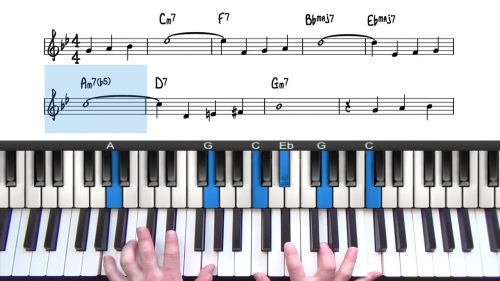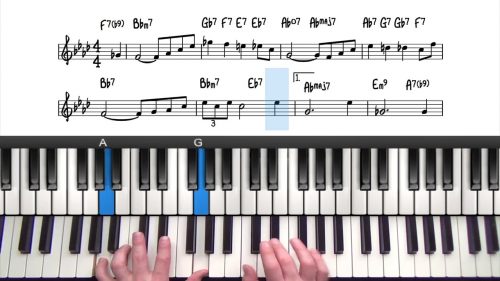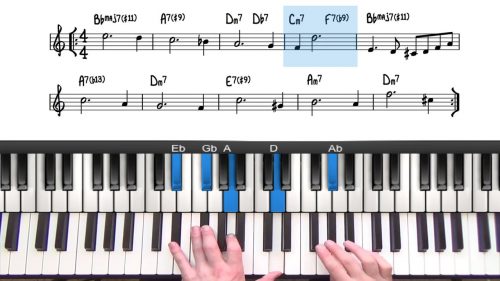Jazz Piano Comping Voicings & Rhythms
One of the most important things to remember is that "Comping" is shorthand for ‘accompanying." It is a subordinate role in the band. You’re job here is to support the soloist by providing a rich harmonic background for them to play or to sing over. You should never get in the soloists way, but instead complement their lines & musical ideas.
In this lesson I’m going to break down the core principles for jazz piano comping. In the first half of the video we will discuss the types of voicings that are suited to comping and then we’ll apply these to both major and minor 251 progressions. Throughout the tutorial we’ll be applying the concepts to the well-known jazz standard ‘Autumn Leaves’.
In the second half of the tutorial we will discuss some rhythmic elements of comping. I’ll start off by introducing the Charleston rhythm and then we will also look at displacing rhythms, anticipating chords, adding passing chords & developing secondary melodies.
The Charleston rhythm is always a good choice for comping, listen to some recordings of Red Garland on YouTube or Spotify – he uses this rhythm frequently and he plays it with a beautifully delicate and light touch. Remember to displace the rhythm.
Lesson Downloads
-
Comping Lesson Supplement File Type: pdf
Practice Tips
-
First learn the 4 note and 6 note variations of the comping voicings in the minor and major keys outlined in the lesson.
-
The 6 note voicings would be suited to a trio or bigger band performance. If you are just accompanying a vocalist, you may find they are too heavy.
-
Play through Autumn Leaves with the iRealPro App to make sure you are keeping good time.
-
Practice using the Charleston Rhythm and also displacing the rhythm onto different beats of the bar.
- Red Garland, Ahmad Jamal and Wynton Kelly are great players to listen to for rhythm inspiration for your comping. The quickest and most effective way to expand your rhythmic vocabulary is through listening and imitating the masters.








Hi, Hayden.
First let me say I’m getting a great deal of very useful advice from your tutorials. This is the best site I’ve found for jazz education.
I do have a question, however. I’ve watched the tutorial on comping, and tried out your suggested voicings for 251. But I have a little difficulty in voicing six note chords. I get the way they sound following the lesson supplement, where the 2 chord is played as written i.e. starting 3rd and 7th reading up in the left hand, and counterchanging in the 5 and 1 for the major, and 7th and 3rd for the minor. But I’ve tried it the other way round (with the 7th and 3rd and 3rd and 7th) as the starting point. In major 251 it seems to work, but I’m not satisfied with my voicings in 251 minor six note chords. Any suggestions? Or do we use only the six note chord voicings as written?
Hi John, I’m really glad to hear you are enjoying the tuition!
You are correct that the left hand notes can be inverted easily with the major 251.
With the minor 251, try these voicings:
For the II-7b5 chord:
Left Hand: root and b5th
Right Hand: Major triad built from a whole step below the root, but played an octave higher. (So for A-7b5, you would play A and Eb in the left hand – and then G-B-D in the right hand).
You will find that you can play the root and b5th in any inversion.
Then when you move to the V7 chord (D7) … play the 3rd and b7 in the left hand (F# and C) and then you can play an upper structure triad with your right hand, Bb Maj triad in it’s second inversion is nice… from bottom to top that’s F, Bb, D (that gives you #5#9) – also try an Ab major triad in it’s 2nd inversion (Eb, Ab, C) to get b9 #11.
Then I like to resolve to a G-11 stacked in thirds… G- triad in the left hand, F Major triad in the right hand to get b7 – 9 – 11 in the right hand.
For the II and the V chords, you can also double the top/bottom note of the right hand triad to get a bigger sound.
Hope this helps answer your question and if you would like me to elaborate on anything just let me know :-)
Cheers,
Hayden
Hi Hayden,
Just found this lesson hidden in the advanced section. This is a very useful lesson that gives me a lot of understanding on how jazz comping works. Good work.
In my opinion if this lesson had appeared in the earlier section (esp when learning transcription) I would have felt less ‘lost’ as it clarifies how rhythm should be played and how to achieve the sound the piano suppose to make in a jazz band as heard in jazz bar or recording.
Thanks Peerapong, really glad you enjoyed the lesson.
I will check out the other course on Transcription and see where this lesson could fit in.
You might also like these transcription studies in the forum:
Red Garland: pianogroove.com/community/t/red-garland-transcription-exercises/4101
Wynton Kelly: pianogroove.com/community/t/wynton-kelly-transcription-exercises/3810
They both focus on left hand comping.
Cheers!
Hayden